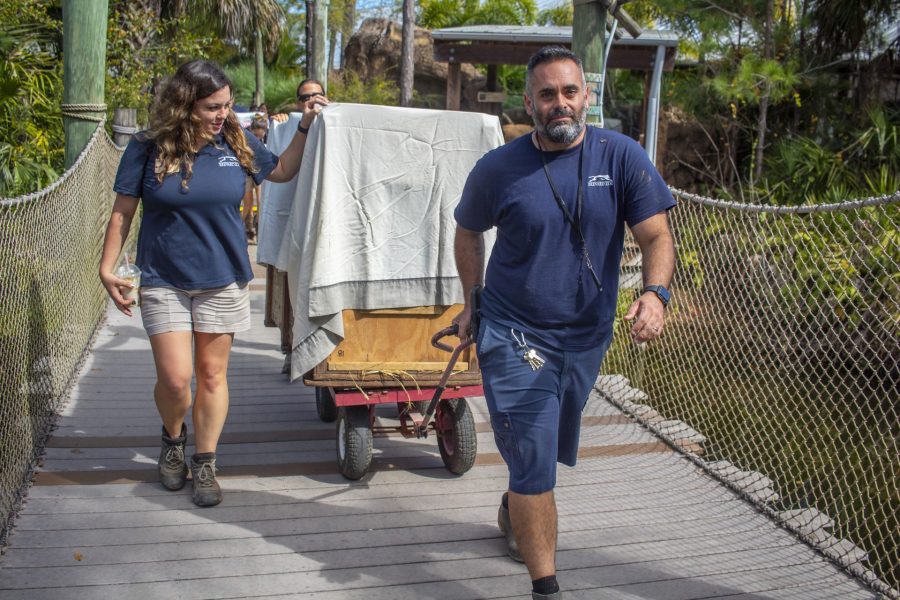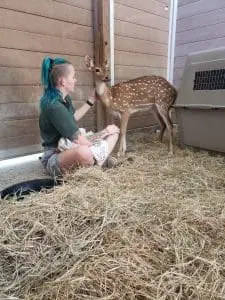

When new animals arrive at our Zoo, they often spend some time in a quarantine space before moving to their public-facing habitat. This helps keep the rest of our animal residents safe from any potential illnesses the newbie may be bringing in. The new animal resident doesn’t get to meet their regular keeper staff quite yet as another safeguard, so our two-person Animal Registrar team cares for them in the meantime! In the last year alone, the team has welcomed a wide variety of animals, from our fallow deer Peach to our bobcat Aries.
This team is made up of our Curator of Animal Data and Regulatory Affairs Sebastian Carcano and Animal Registrar Shelby Orth. Shelby is the primary quarantine keeper, and Sebastian is her manager and mentor. She spends the most time caring for our quarantine animals with Sebastian’s guidance on prepping the habitats, care guidelines, animal training, and assisting our veterinary staff during the quarantine medical exams.
 Our quarantine keepers ensure the rest of the zoo animals and staff stay safe by maintaining biosecurity. This means wearing special protective gear while servicing quarantine animals, using specialized disinfectants and cleaning procedures, and using dedicated tools/dishes/enrichment items to eliminate any potential cross contamination.
Our quarantine keepers ensure the rest of the zoo animals and staff stay safe by maintaining biosecurity. This means wearing special protective gear while servicing quarantine animals, using specialized disinfectants and cleaning procedures, and using dedicated tools/dishes/enrichment items to eliminate any potential cross contamination.
The duo also does their best to make the quarantine time as safe and positive for the animal as possible. Often, a new resident arrives to our Zoo stressed from all that comes from moving to another facility, such as moving from their previous habitat for a medical exam, placement in a secure carrier, and transport.
Before the new resident’s arrival, the team gets as much information on them as possible, everything from their current habitat’s makeup to their personality. The quarantine space is made as comfortable as possible.
“For example, if this particular individual has a history of being shy, the quarantine stalls are set up to ensure maximum privacy with lots of foliage, shade coverings, multiple hiding spaces, and limiting any human traffic in the area as they adjust,” Sebastian said. “If a particular individual is very social and was previously part of a group, we set aside a big portion of the day to spend time bonding with them and giving them the social interactions they are used to.”
Bonding sessions are so important, Sebastian said. This team often must prepare very shy animals for life at the Zoo with guests and big teams of animal care staff. Fallow deer Peach came from a place where there was little to no human contact or interaction. She was initially very flighty and hesitant with people, which would make adjusting to her new home in Wild Florida difficult. After many positive bonding sessions with Shelby, Peach has become comfortable around keepers and guests!
Training sessions are also important during quarantine. These new animals will usually need a medical exam before being cleared to leave quarantine and then have another internal move in a secure carrier ahead of them. Our Zoo was recently a stopping point for a white-nosed coati named Scraps, who was headed to another facility. Our Registrar team heard he struggled to enter a secure carrier during the first leg of his trip, so they worked with him to make the next transfer smoother.
“Crate training, shifting and scale training become our priority projects for almost all animals in quarantine,” Sebastian said. “Giving these animals the choice to participate in their own care is important because it empowers them and builds up their confidence, strengthens trust between us and them, and makes the transport process as stress-free as possible!”
Brevard Zoo is an independent, not-for-profit organization that receives no recurring government funding for our operating costs. Your generous support enables us to continue to serve our community and continue our vital animal wellness, education and conservation programs.